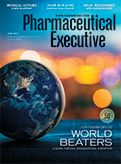A Critical Juncture for Antibiotic R&D
Pharmaceutical Executive
With little momentum in developing new new antibiotics to fight antimicrobial resistance, the time is now to emphasize "push" and "pull" incentives and demonstrate how innovation in this area will lead to patient benefit and economic reward.
In a 2016
analysisof the deepening health threat posed by antimicrobial resistance (AMR), economist Jim O’Neill predicted that by the year 2050, the number of deaths resulting from AMR will overtake those caused by cancer. Recommendations from O’Neill on combatting the crisis aligned with governmental bodies, medical societies, health charities, and public health organizations. They include awareness campaigns about the inappropriate use of antibiotics; incentives encouraging development of truly innovative antibiotics and new diagnostics; a focus on antibiotic stewardship across health settings; and a sharp reduction in the use of antibiotics in agriculture.
While AMR is a priority issue on the political agenda and in healthcare policy, there is a lack of tangible momentum in the development of new antibiotics. If you define a new class of antibiotics as one that hits a new target, there has not been a new class developed for nearly two decades. Instead, we have seen analogues of existing classes that generally offer only incremental improvements over existing drugs.
As AMR began to become a major issue, hospital antibiotic stewardship programs took a critical look at what drugs should be used, how quickly, and for which patients. Stewardship committees began to debate whether new antibiotics were worth the cost. Payers favored generics, and because the antibiotics were analogues developed in non-inferiority trials, drug companies often didn’t have the data to make an argument of sufficient differentiation in support of higher pricing for new therapies.
While blame for the malaise that has dogged antibiotic development can’t be attributed to a single source, the entire healthcare ecosystem now has a responsibility to pull together to deliver progress. The key to the revival of this sector and finding solutions to AMR lies in innovation: scientific, medical, marketing, financial, and regulatory.
In order to reintroduce innovation to antibiotic development to address the AMR crisis, “push” and “pull” initiatives have been instituted. Push incentives include public research funding; pull incentives are commercial enticements that better guarantee a return on the substantial investment required to bring a drug to market. We are seeing some success with push incentives that provide funding for antibiotic discovery and development, but less progress with pull incentives that will help bring new ones to market.
The economics of bringing new compounds to market remain very challenging for investors, so many have shunned the space in favor of more profitable areas of drug development. The same is true for the pharmaceutical industry-today, only two big companies are still actively involved in antibiotic development. However, there are a number of smaller firms working to develop completely new-mechanism, targeted antibiotics. If we can develop the agent so that it can demonstrate superior clinical outcomes for the patient, we can also drive down costs for governments and healthcare systems.
Prescribers may be unintentionally shutting down pathways to innovations that will help usher in new drugs and lower costs. Doctors may have fallen into the habit of prescribing antibiotics that may be inappropriate, and hospitals move slowly in reviewing treatment guidelines-typically every five years, which is far too long for novel drugs to be introduced into the hospital system.
The healthcare system also needs to consider the long-term health economics of antibiotic prescription. Paying more for a new-mechanism antibiotic upfront makes sense if it can improve patient cure rates and lead to a reduction in the burden on healthcare systems and the associated expense further down the line.
Scientific advances are making the discovery of targeted antibiotics possible. For instance, genetic modification and next-generation sequencing of bacteria have accelerated drug discovery. This progress, coupled with the rise of rapid diagnostics to identify the bacterial cause of an infection, mean that highly targeted, new-mechanism drugs could be available to kill specific bacteria, providing new front-line therapies for patients. Existing broad-spectrum agents can then be reserved for difficult cases. This could also result in a reduction in AMR.
We’re now at a critical juncture. Push and pull incentives are required and the industry needs to demonstrate how innovation in antibiotic development will lead to patient benefit and economic reward. We have a unique opportunity to revive the engine room of antibiotic development to bring wider medical and societal benefits-let’s not miss it.

David Roblin, MD, is Chief Medical Officer and President of Research and Development at Summit Therapeutics

FDA Grants Priority Review to Regeneron’s Eylea for Macular Edema Following Retinal Vein Occlusion
April 18th 2025Regulatory action was based on data from the Phase III QUASAR trial, which demonstrated that Eylea HD dosed every eight weeks achieved non-inferior visual acuity outcomes compared to Eylea in patients with macular edema following retinal vein occlusion.
Addressing Disparities in Psoriasis Trials: Takeda's Strategies for Inclusivity in Clinical Research
April 14th 2025LaShell Robinson, Head of Global Feasibility and Trial Equity at Takeda, speaks about the company's strategies to engage patients in underrepresented populations in its phase III psoriasis trials.
New Insights Into T Cell Exhaustion and Inflammation in Long COVID
April 17th 2025Nigel McCracken, chief operating officer, Virax Biolabs, discusses new findings that reveal altered cytokine activity and evidence of T cell exhaustion in long COVID patients, providing deeper insight into post-infection immune disruption.
Key Findings of the NIAGARA and HIMALAYA Trials
November 8th 2024In this episode of the Pharmaceutical Executive podcast, Shubh Goel, head of immuno-oncology, gastrointestinal tumors, US oncology business unit, AstraZeneca, discusses the findings of the NIAGARA trial in bladder cancer and the significance of the five-year overall survival data from the HIMALAYA trial, particularly the long-term efficacy of the STRIDE regimen for unresectable liver cancer.
Amgen’s Imdelltra Demonstrates Significant Overall Survival Improvement in Small Cell Lung Cancer
April 16th 2025In the Phase III DeLLphi-304 trial, patients with small cell lung cancer administered Imdelltra achieved a statistically significant and clinically meaningful improvement in overall survival compared to standard-of-care chemotherapy.